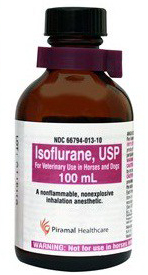By Dr. Michael J. Huerkamp, DVM, DACLAM
 Isoflurane, known by the brand names Forane and Aerrane, is popularly used for the anesthesia of rodents, including in laboratories by making use of induction chambers. The same properties of quick induction, rapid effect, and the need for close monitoring to prevent the undesirable effects of overdose enabled by its high vapor pressure, also create risks for human operators to be exposed to the gas and its effects. Fortunately, isoflurane is an exceptionally safe agent in terms of toxic properties as demonstrated through decades of use in human and veterinary patients, although there may be uncertain risk in pregnancy with significant, regular exposure. While there have been no specific Isoflurane exposure guidelines developed by NIOSH, OSHA or any other pertinent safety entity, the chemical is a skin irritant, necessitating the wearing of gloves when decanting it, and vapor exposure may be irritating to the eyes and respiratory tract and may cause lightheadedness. Because one can never be too safe, it is important to respect that the agent may have unknown risks and take common sense precautions in preventing exposure.
Isoflurane, known by the brand names Forane and Aerrane, is popularly used for the anesthesia of rodents, including in laboratories by making use of induction chambers. The same properties of quick induction, rapid effect, and the need for close monitoring to prevent the undesirable effects of overdose enabled by its high vapor pressure, also create risks for human operators to be exposed to the gas and its effects. Fortunately, isoflurane is an exceptionally safe agent in terms of toxic properties as demonstrated through decades of use in human and veterinary patients, although there may be uncertain risk in pregnancy with significant, regular exposure. While there have been no specific Isoflurane exposure guidelines developed by NIOSH, OSHA or any other pertinent safety entity, the chemical is a skin irritant, necessitating the wearing of gloves when decanting it, and vapor exposure may be irritating to the eyes and respiratory tract and may cause lightheadedness. Because one can never be too safe, it is important to respect that the agent may have unknown risks and take common sense precautions in preventing exposure.
Isoflurane to induce anesthesia in rodents can be accomplished at a 3-5% concentration. A common way to achieve this is to infuse the gas into a closed induction chamber using a precision vaporizer with a properly used and maintained scavenging system. Use the open-drop method, availing a glass vacuum dessicator/bell jar or equivalent tightly closed container or Ziploc bag and otherwise adhering to the methods of use in the IACUC-approved protocol, should be done in a fume hood, safely ducted biosafety cabinet, or downdraft or backdraft work station. If it is not practical to use a fume hood or other appropriate engineering control and the procedure must be accomplished on an open bench top, use precisely measured amounts of the gas to charge and replenish the chamber and only open the receptacle when adding or removing subjects or adding isoflurane. The Division of Animal Resources has found a safe standard to achieve a 2-4% gas concentration for induction by using 0.2 ml isoflurane liquid per 1000 ml of chamber volume as a start and replenished every 3 or so batches of rodents. While the concentration of gas will be highest at its source in the container, introducing excessive, inexact amounts risks a high concentration permeating into the lab itself from the chamber when opened and possibly exposing and affecting human occupants. If you have questions or concerns about the appropriateness of your anesthesia induction arrangement or need assistance with a set-up, please contact the DAR veterinary staff (7-3248 or darcust@emory.edu). Safety evaluations and exposure monitoring associated with the use of isoflurane can be arranged by request with the specialists in EHSO (indhyg@emory.edu).
Leave a Reply